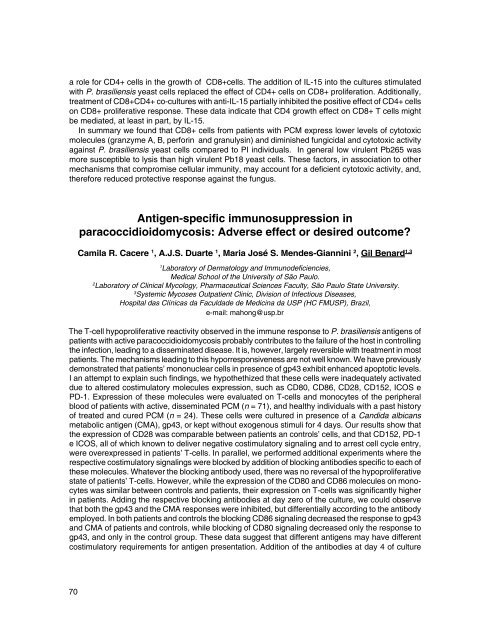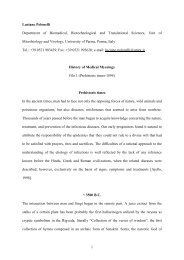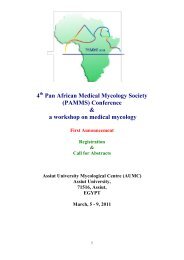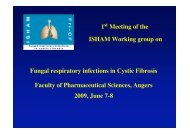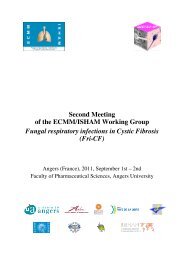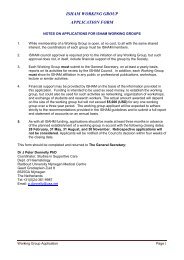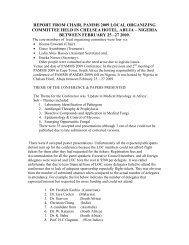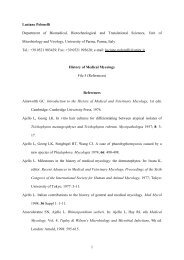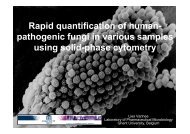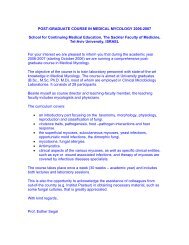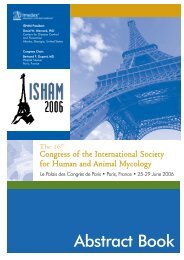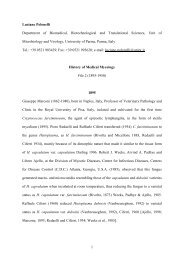Memoria CD.indd - ISHAM
Memoria CD.indd - ISHAM
Memoria CD.indd - ISHAM
You also want an ePaper? Increase the reach of your titles
YUMPU automatically turns print PDFs into web optimized ePapers that Google loves.
a role for <strong>CD</strong>4+ cells in the growth of <strong>CD</strong>8+cells. The addition of IL-15 into the cultures stimulatedwith P. brasiliensis yeast cells replaced the effect of <strong>CD</strong>4+ cells on <strong>CD</strong>8+ proliferation. Additionally,treatment of <strong>CD</strong>8+<strong>CD</strong>4+ co-cultures with anti-IL-15 partially inhibited the positive effect of <strong>CD</strong>4+ cellson <strong>CD</strong>8+ proliferative response. These data indicate that <strong>CD</strong>4 growth effect on <strong>CD</strong>8+ T cells mightbe mediated, at least in part, by IL-15.In summary we found that <strong>CD</strong>8+ cells from patients with PCM express lower levels of cytotoxicmolecules (granzyme A, B, perforin and granulysin) and diminished fungicidal and cytotoxic activityagainst P. brasiliensis yeast cells compared to PI individuals. In general low virulent Pb265 wasmore susceptible to lysis than high virulent Pb18 yeast cells. These factors, in association to othermechanisms that compromise cellular immunity, may account for a deficient cytotoxic activity, and,therefore reduced protective response against the fungus.Antigen-specific immunosuppression inparacoccidioidomycosis: Adverse effect or desired outcome?Camila R. Cacere 1 , A.J.S. Duarte 1 , Maria José S. Mendes-Giannini 2 , Gil Benard 1,31Laboratory of Dermatology and Immunodeficiencies,Medical School of the University of São Paulo.2Laboratory of Clinical Mycology, Pharmaceutical Sciences Faculty, São Paulo State University.3Systemic Mycoses Outpatient Clinic, Division of Infectious Diseases,Hospital das Clínicas da Faculdade de Medicina da USP (HC FMUSP), Brazil,e-mail: mahong@usp.brThe T-cell hypoproliferative reactivity observed in the immune response to P. brasiliensis antigens ofpatients with active paracoccidioidomycosis probably contributes to the failure of the host in controllingthe infection, leading to a disseminated disease. It is, however, largely reversible with treatment in mostpatients. The mechanisms leading to this hyporresponsiveness are not well known. We have previouslydemonstrated that patients’ mononuclear cells in presence of gp43 exhibit enhanced apoptotic levels.I an attempt to explain such findings, we hypothethized that these cells were inadequately activateddue to altered costimulatory molecules expression, such as <strong>CD</strong>80, <strong>CD</strong>86, <strong>CD</strong>28, <strong>CD</strong>152, ICOS ePD-1. Expression of these molecules were evaluated on T-cells and monocytes of the peripheralblood of patients with active, disseminated PCM (n = 71), and healthy individuals with a past historyof treated and cured PCM (n = 24). These cells were cultured in presence of a Candida albicansmetabolic antigen (CMA), gp43, or kept without exogenous stimuli for 4 days. Our results show thatthe expression of <strong>CD</strong>28 was comparable between patients an controls’ cells, and that <strong>CD</strong>152, PD-1e ICOS, all of which known to deliver negative costimulatory signaling and to arrest cell cycle entry,were overexpressed in patients’ T-cells. In parallel, we performed additional experiments where therespective costimulatory signalings were blocked by addition of blocking antibodies specific to each ofthese molecules. Whatever the blocking antibody used, there was no reversal of the hypoproliferativestate of patients’ T-cells. However, while the expression of the <strong>CD</strong>80 and <strong>CD</strong>86 molecules on monocyteswas similar between controls and patients, their expression on T-cells was significantly higherin patients. Adding the respective blocking antibodies at day zero of the culture, we could observethat both the gp43 and the CMA responses were inhibited, but differentially according to the antibodyemployed. In both patients and controls the blocking <strong>CD</strong>86 signaling decreased the response to gp43and CMA of patients and controls, while blocking of <strong>CD</strong>80 signaling decreased only the response togp43, and only in the control group. These data suggest that different antigens may have differentcostimulatory requirements for antigen presentation. Addition of the antibodies at day 4 of culture70


